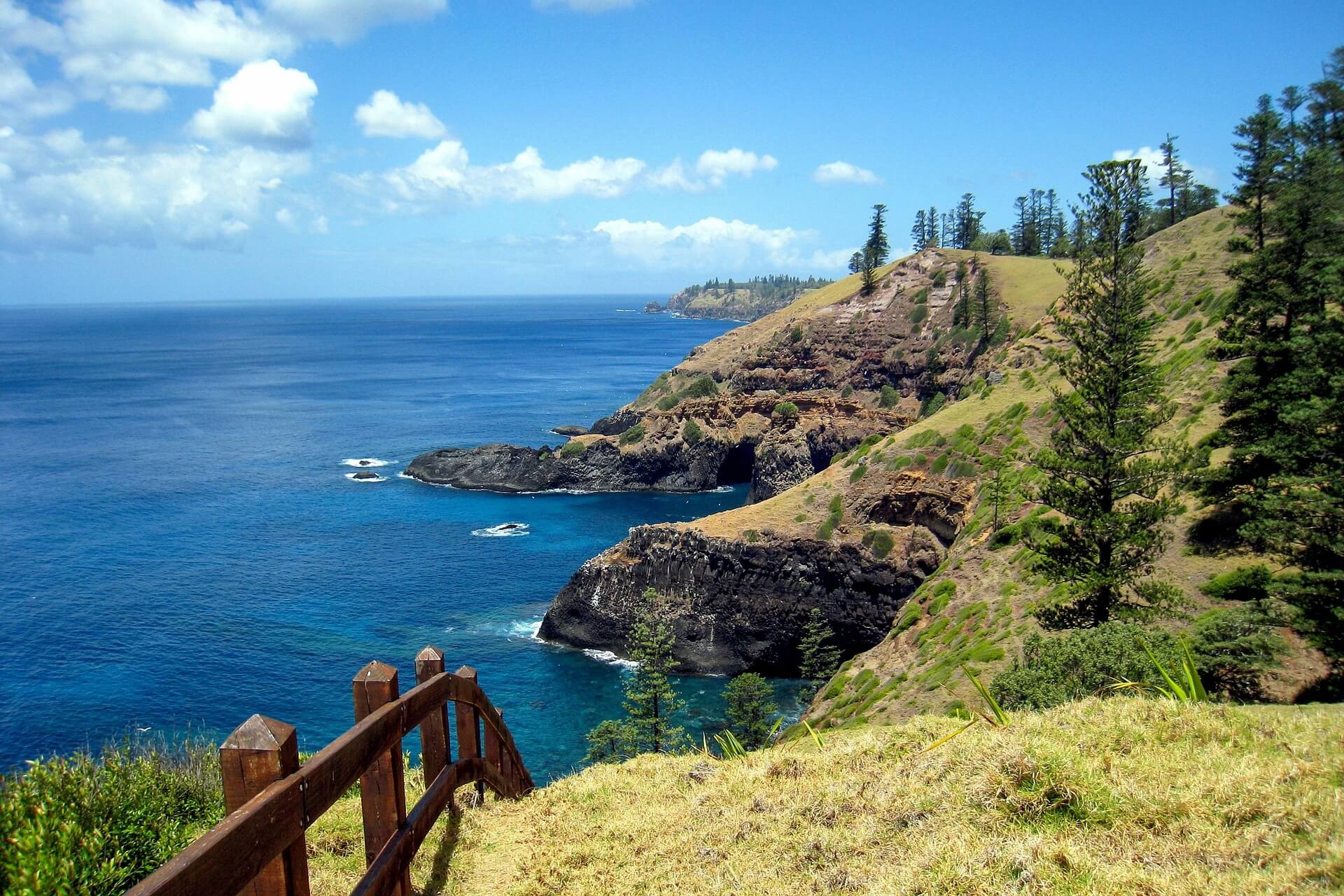Discover Norfolk Island

History, nature, and serenity — a South Pacific island like no other
Nestled between Australia, New Zealand, and New Caledonia, Norfolk Island is a quiet, green jewel floating in the South Pacific. It’s not your typical island paradise: instead of lagoons and palm trees, you’ll find dramatic sea cliffs, rolling pastures, dense pine forests, and some of the most fascinating colonial history in the Pacific.
This small Australian external territory is a rare blend of pristine nature, World Heritage convict-era ruins, Polynesian ancestry, and deeply rooted community life. It’s a place where cows have right of way on the roads, locals speak Norf’k (a creole of English and Tahitian), and visitors are welcomed not as tourists, but as temporary residents.
How to Get to Norfolk Island
Norfolk Island is easy to reach from Australia, with direct flights operating from:
- Brisbane and Sydney several times a week (flight time: ~2.5 hours).
- Flights are operated by Qantas under a domestic flight model, but passport identification is still required, as the island is outside Australia’s immigration zone.
There are no international flights from New Zealand or other countries currently, though charter flights may operate seasonally. Norfolk Island Airport (NLK) is just minutes from the main township of Burnt Pine.
What to See in Norfolk Island
Kingston, on the island’s southern coast, is one of the most important historic sites in the South Pacific. This area — part of the Kingston and Arthur’s Vale Historic Area (KAVHA) — is a UNESCO-listed site that preserves the grim yet fascinating legacy of the British penal colonies. You can wander among crumbling convict ruins, restored Georgian buildings, old cemeteries, and coastal fortifications with sweeping ocean views.
North of Kingston lies Emily Bay, a beautiful crescent of calm water protected by a coral reef — ideal for swimming, snorkeling, and picnicking. It’s one of the few accessible beaches on the island and perfect for families.
Norfolk Island National Park, covering much of the northern interior, is home to walking trails, native birds, and the iconic Norfolk Island pine (Araucaria heterophylla). Hike to Mount Pitt or Mount Bates, the island’s highest points, for panoramic views over the entire coastline and nearby Phillip and Nepean Islands.
The nearby Botanic Garden showcases endemic flora and offers an easy stroll through regenerating forest, with interpretive signs about local ecosystems and conservation efforts.
In the island’s west, Captain Cook’s Lookout marks the explorer’s 1774 landing and provides one of the island’s most breathtaking ocean panoramas — especially at sunset.
What to Do in Norfolk Island
Norfolk Island invites you to slow down and reconnect — with history, with nature, and with a simpler way of life.
History buffs can take guided or self-paced tours of the Kingston penal settlement, explore the Bounty mutineer heritage of the island’s current population (descended from Pitcairn Islanders), and visit excellent museums like the Pier Store, Sirius Museum, and the Norfolk Island Research Centre.
Nature lovers can walk over 30 km of hiking trails, snorkel in coral gardens, birdwatch endangered species like the green parrot, or take boat trips around Phillip Island — a rugged, uninhabited sanctuary home to seabird colonies and spectacular volcanic terrain.
For culture and community, attend a fish fry with live music, join a language class in Norf’k, or visit the Sunday markets in Burnt Pine. Norfolk’s creative scene is also growing, with small galleries, woodworking shops, and local food producers opening their doors to visitors.
If you’re feeling adventurous, try glass-bottom boat tours, horse riding, golfing on one of the world’s most scenic courses, or even surfing in the right conditions (usually off Anson Bay).
When to Visit Norfolk Island
Norfolk Island has a mild subtropical climate year-round.
- Best months to visit: September to May offers warm days, clear skies, and calm seas.
- Winter (June to August) is cooler and windier but perfect for hiking and avoiding peak travel periods.
Events such as Foundation Day (March), Bounty Day (June 8), and Taste Norfolk Island (December) give visitors an opportunity to experience local culture firsthand.
Travel Tips for Norfolk Island
- Currency: Australian Dollar (AUD)
- Language: English and Norf’k (a unique Pitcairn-English creole)
- Time zone: GMT+11 (no daylight saving)
- Getting around: Rental cars are highly recommended — there’s no public transport. Be ready to wave at oncoming cars (a local tradition known as the “Norfolk wave”).
- Connectivity: Mobile coverage is limited; local SIMs are available. Wi-Fi is offered in many accommodations but may be slower than on the mainland.
Norfolk Island is not your average tropical getaway — it’s an island of stories, where centuries of history meet untamed natural beauty and a tight-knit, proudly independent culture. Whether you’re walking along convict-era walls, snorkeling off a reef just steps from a museum, or watching cows graze under pine trees near the ocean, you’ll find a peaceful rhythm that’s increasingly rare in the world.
This is a destination for the curious, the thoughtful, and those who travel not just to relax, but to understand. On Norfolk Island, you won’t just visit — you’ll feel like you belong.